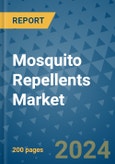Market Overview and Growth Projections
The global mosquito repellent market is forecasted to surpass US$10,689.6 Mn by the end of 2026, with a notable CAGR of 8.0% during the forecast period. The increasing adoption of mosquito repellents as home care products for disease prevention is a key factor driving market growth. Various types of mosquito repellents, including coils, creams, sprays, vaporizers, and oils, play a crucial role in efficiently preventing mosquito-borne diseases.Shift towards Bio-based Repellents and Online Sales
Bio-based mosquito repellents have witnessed higher traction in the market compared to synthetic counterparts. While retail stores remain significant in terms of value and volume share, the online segment is expected to witness robust growth in the coming years. Specific initiatives aimed at vector disease prevention are further expected to boost demand for mosquito repellents globally.Insights into Research Methodology
PMR adopts a modeling-based approach and triangulation methodology for data collection, market profiling, pricing analysis, and forecast development. The report provides detailed insights into the volume consumption of mosquito repellents, tracking production capacities and pricing analysis for various product segments.Market Dynamics and Future Outlook
The market is anticipated to expand at a rate of 8.0% over the forecast period, driven by increasing demand from developing economies such as India, South Africa, and Brazil. Synthetic repellents containing DEET are commonly used, although bio-based alternatives are gaining traction due to their fragrance and skin-friendly properties. The global market is poised to witness a robust growth rate of 8.0% over the forecast period, fueled by escalating demand for mosquito repellents, particularly in developing economies like India, South Africa, Brazil, among others. This surge in demand is primarily driven by the escalating prevalence of vector-borne diseases, prompting increased adoption of mosquito repellents for disease prevention.Synthetic repellents containing DEET remain the most widely used mosquito repellents due to their effectiveness in repelling mosquitoes upon contact. However, the oily sensation, strong odor, and skin irritation associated with DEET-based repellents have hindered their growth. Conversely, bio-based mosquito repellents derived from plants offer various advantages, including pleasant fragrance, skin-friendly properties, and effective vapor action without irritation, fostering a positive growth trajectory for the market.
Recognizing the health benefits of natural mosquito repellents, market leaders have introduced a range of innovative products, such as body sprays, wipes, roll-ons, and hand bands, designed to offer effective protection against mosquitoes. Additionally, companies have launched plug-in mats and candles emitting natural scents disliked by mosquitoes, catering to diverse consumer preferences.
Despite advancements in commercial repellents, the use of herbal leaves and homemade remedies remains prevalent, particularly in rural areas of developing countries, where approximately 56% of the Indian market still relies on non-branded mosquito repellents. Challenges such as limited access to electricity and low-income households have constrained the adoption of advanced repellent products like creams, vaporizers, and sprays in these regions.
The global market faces challenges such as the emission of harmful smoke from coils and the high prices of certain repellent products. To address these challenges, ongoing research focuses on developing alternative materials for mosquito repellents, which is expected to positively impact the market during the forecast period.
According to the World Health Organization, approximately 80% of the global population is at risk of one or more vector-borne diseases, resulting in over 700,000 deaths annually. In response, health organizations like WHO and UNICEF advocate for the use of both synthetic (DEET-based) and natural mosquito repellents to mitigate the risk of mosquito-borne diseases, underscoring the critical role of repellents in public health initiatives.
Key Players and Market Structure
The global mosquito repellent market is highly consolidated, with major players such as S.C. Johnson and Sons, 3M, and Godrej Consumer Products Limited dominating the market. Companies are focusing on launching innovative products, including body sprays, wipes, and hand bands, to address evolving consumer preferences and market demands.Market Segmentation
Product Type
- Coil
- Cream
- Mat
- Spray/Aerosols
- Vaporizer
- Oil
- Others
Source
- Synthetic Mosquito Repellent
- Bio-based Mosquito Repellent
Sales Channel
- Retail
- Online
- Supermarket
- Others
Region/Country
- North America
- Latin America
- Europe
- APEC (Asia Pacific excluding China)
- China
- Japan
- Middle East and Africa
This product will be delivered within 1-3 business days.








